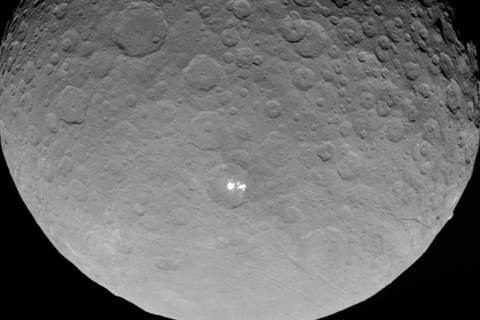New Close-Up Images of Dwarf Planet Ceres Reveal its Best Spots
| Marco Foronda | | May 12, 2015 07:02 AM EDT |
(Photo : NASA/JPL-Caltech/UCLA/MPS/DLR/IDA) In this closest-yet view of Ceres, the brightest spots within a crater in the northern hemisphere are revealed to be composed of many smaller spots. This frame is from an animation of sequences taken by NASA's Dawn spacecraft on May 4, 2015.
The mysterious bright spots on the dwarf planet Ceres are better resolved in a new sequence of images taken by NASA's Dawn spacecraft on May 3 and 4, 2015. The images were taken from a distance of 8,400 miles (13,600 kilometers).
The latest images from the Dawn spacecraft reveal that the pair of spots is comprised of even more spots.
Like Us on Facebook
“Dawn scientists can now conclude that the intense brightness of these spots is due to the reflection of sunlight by highly reflective material on the surface, possibly ice,” said Christopher Russell, principal investigator for the Dawn mission from the University of California, Los Angeles.
These images offer scientists new insights into crater shapes and sizes, and a host of other intriguing geological features on the surface. The image resolution is 0.8 mile (1.3 kilometers) per pixel.
Dawn, the first spacecraft to visit a dwarf planet, will take a second, began its decent towards its second mapping orbit, where it will get a closer look, on May 9. It is expected to reach its next destination on June 6 where the probe will circle the planet from an altitude of 2,700 miles, almost 3 times closer than the previous orbit.
Scientists also hope the bird’s eye view will reveal clues of ongoing geological activity.
There’s no doubt a lot’s been happening on Ceres. One look at all those cracks hints at either impact-related stresses some kind of crustal expansion. Geological processes may still make this little world rock and roll.
TagsNew Close-Up Images of Dwarf Planet Ceres Reveal its Best Spots, Ceres, dwarf planet, spots on dwarf planet, bright spots, space exploration
©2015 Chinatopix All rights reserved. Do not reproduce without permission
EDITOR'S PICKS
-

Did the Trump administration just announce plans for a trade war with ‘hostile’ China and Russia?
-

US Senate passes Taiwan travel bill slammed by China
-

As Yan Sihong’s family grieves, here are other Chinese students who went missing abroad. Some have never been found
-

Beijing blasts Western critics who ‘smear China’ with the term sharp power
-

China Envoy Seeks to Defuse Tensions With U.S. as a Trade War Brews
-

Singapore's Deputy PM Provides Bitcoin Vote of Confidence Amid China's Blanket Bans
-

China warns investors over risks in overseas virtual currency trading
-

Chinese government most trustworthy: survey
-

Kashima Antlers On Course For Back-To-Back Titles
MOST POPULAR
LATEST NEWS
Zhou Yongkang: China's Former Security Chief Sentenced to Life in Prison

China's former Chief of the Ministry of Public Security, Zhou Yongkang, has been given a life sentence after he was found guilty of abusing his office, bribery and deliberately ... Full Article
TRENDING STORY

China Pork Prices Expected to Stabilize As The Supplies Recover

Elephone P9000 Smartphone is now on Sale on Amazon India

There's a Big Chance Cliffhangers Won't Still Be Resolved When Grey's Anatomy Season 13 Returns

Supreme Court Ruled on Samsung vs Apple Dispute for Patent Infringement

Microsoft Surface Pro 5 Rumors and Release Date: What is the Latest?










